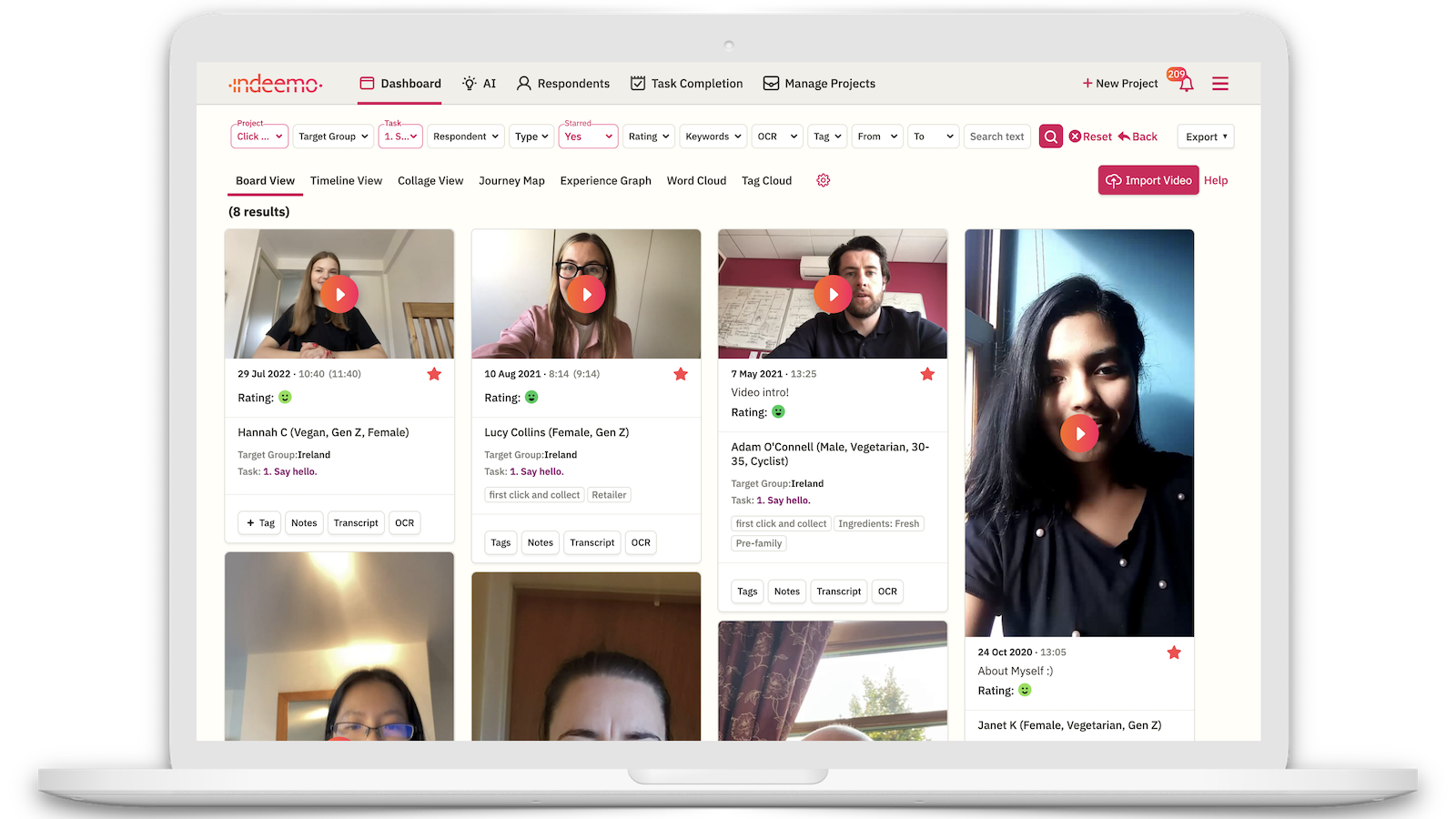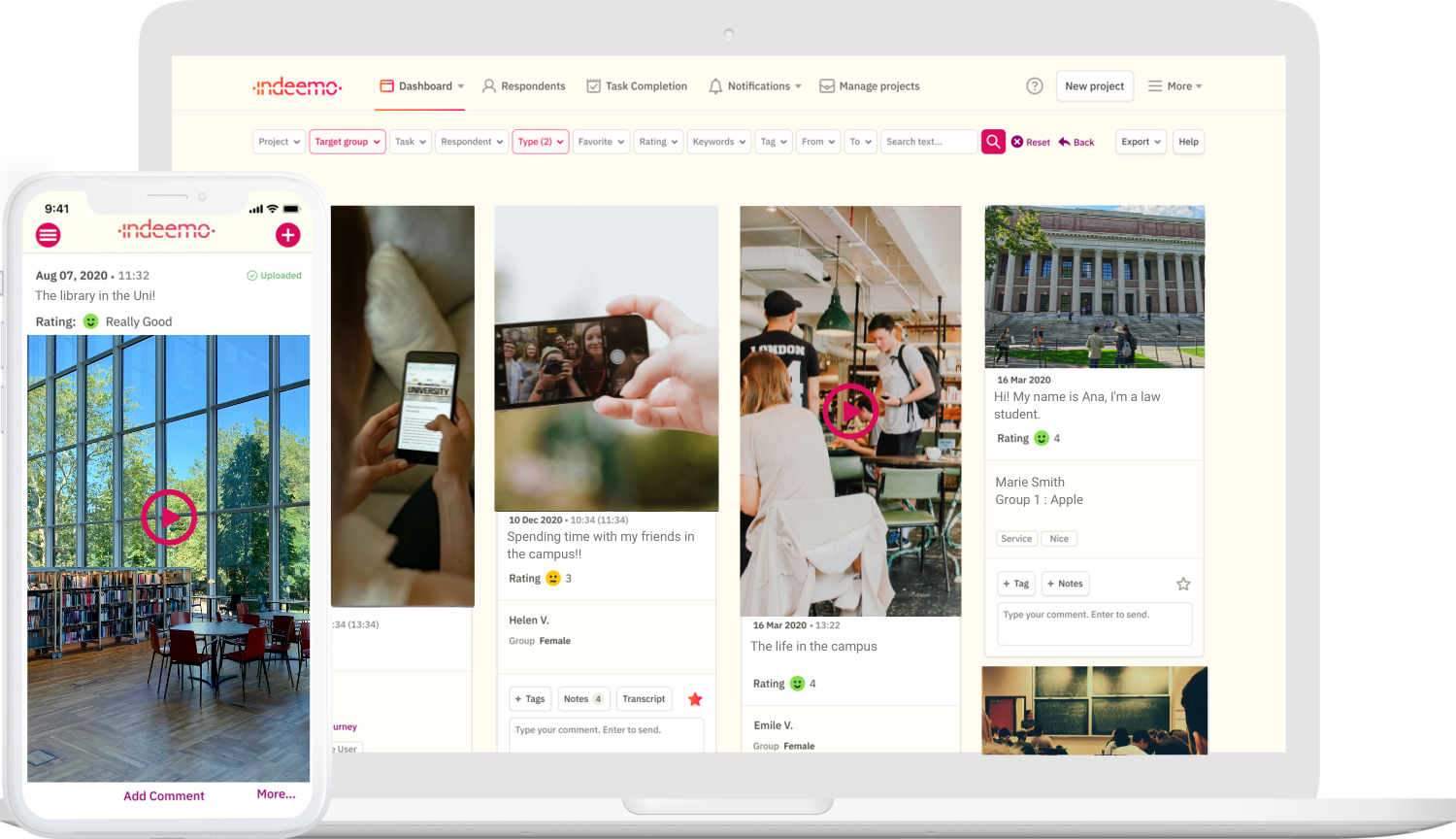Understanding Student Experience with Video & In the Moment Research: A Guide for Researchers
Understanding the nuanced and ever-evolving university student experience, whilst a growing research initiative undertaken by higher education institutions and marketing agencies, is a complex task that requires innovative methods and tools. The use of in-the-moment diaries, specifically captured through video via specialised apps like Indeemo, offers researchers an unparalleled window into the daily lives, thoughts, and feelings of students. As Indeemo continues to facilitate research agendas on student experience, this blog provides a comprehensive guide on designing tasks and strategies for researchers keen on delving deep into the student experience, employing a longitudinal research (Always On) approach to gather rich, context-laden insights.
Research & Task Design for Student Experience
When studying complex and dynamic environments like university life, the design of your research tasks is pivotal. The effectiveness of your research hinges not just on the questions you ask, but crucially on how you ask them. Designing the right tasks in the right way can illuminate the student experience in profound and unexpected ways, providing insights that are both deep and broad. The foundation of any successful research project is a robust design that aligns closely with your research objectives.
Setting Clear Objectives
Before task design, it's essential to define clear and achievable objectives. These objectives should reflect the broader goals of the research but be specific enough to guide task design effectively. Objectives not only focus the study but also provide a benchmark against which to measure its success.
For example, if the objective is to understand how new students adapt to university life, tasks might be designed to explore various adaptation processes, from academic challenges to social integration. Once objectives are set, tasks must be meticulously designed to align with these goals. Each task should have a clear purpose and contribute directly to the research objectives, helping to construct a comprehensive picture of the student experience. This alignment ensures that every piece of data collected is both useful and insightful.
To capture the multifaceted nature of student life, it’s crucial to design tasks that explore various aspects of their experience. Here are some task ideas to get you started:
Pre-Semester Reflections
Ask students to document their feelings, expectations, and anxieties before the semester begins. This can reveal insights into their hopes and fears, setting a baseline for their journey.
Academic Integration
Tasks can include documenting how students manage their timetables, lecture schedules, and the integration of academic tools into their study routines. This provides a glimpse into their organisational skills and adaptation strategies.
Campus Life Exploration
Encourage students to explore and reflect on the physical environment of the campus. Their experiences of these spaces can offer insights into the role of the physical university environment in shaping their academic journey.
Social Interactions
Assign tasks focusing on social interactions, both within and outside academic settings. Understanding their social networks can provide valuable context for their overall university experience.
Health and Wellbeing
Tasks that prompt students to discuss their health, wellness, and coping strategies can shed light on the crucial aspect of student wellbeing.
Benefits of Longitudinal Approach to Student Experience Research
Adopting a longitudinal approach allows researchers to capture the evolving nature of the student experience over time. This "always on" strategy ensures that no nuance or subtle shift in attitudes, behaviours, and feelings is missed. For instance, the freshers' week experience can drastically differ from the mid-semester hustle. Implementing regular tasks, such as daily or weekly diaries, enables researchers to track these changes and understand the factors driving them.
Furthermore, a longitudinal design enhances the reliability and validity of the research findings. By observing students across different phases of their university life, researchers can identify patterns and trends that may not be apparent in cross-sectional studies. This method also allows for the observation of cause-and-effect relationships, providing insights into how and why students' experiences change over time. For example, researchers can examine the impact of initial social interactions on later academic performance or mental health outcomes. Such dynamic insights are invaluable for universities aiming to support their students comprehensively, from induction through to graduation, adapting services and interventions to meet changing needs effectively.

Additional Capabilities
In addition to Video Surveys, you can also do the following with Indeemo:
• Recruit Participants in hours
Recruit B2C and B2B participants in hours from a panel of 3 million+ Respondents.
• Speed up analysis with Generative AI
Use Generative AI prompts for summarisation, translation, thematic analysis, sentiment analysis etc. and reduce analysis time by at least 40%.
• Analyse Interviews and IDIs
Import your interviews from Zoom, Microsoft Teams or your computer, transcribe them in 27 languages and analyse them fast with Generative AI.
• Analyse Interviews and IDIs
Import your interviews from Zoom, Microsoft Teams or your computer, transcribe them in 27 languages and analyse them fast with Generative AI.
Understanding the Student Experience with Video
Video diaries and video surveys stand out as an optimal form of insights gathering for several reasons:
Contextual Richness
Video captures not just the verbal response but also non-verbal cues such as body language and emotions, offering a more comprehensive understanding of the student experience. This multi-dimensional data collection can reveal subtleties that textual data might miss, such as the hesitation in a student’s voice or the enthusiasm sparked by certain activities or topics, providing deeper insight into their true feelings and reactions.
Authenticity
Videos provide a genuine glimpse into the students' environments, helping researchers grasp the real-world contexts of their experiences. By observing students in their own spaces, whether dorm rooms, common areas, or classrooms, researchers can better understand the factors in these environments that influence student behaviour and attitudes.
Engagement
The format can be more engaging for both participants and researchers, making the research process more interactive and less tedious. For students, creating video diaries can feel more personal and less formal than traditional research methods, which can lead to more open and honest expressions of their thoughts and feelings. For researchers, video offers a more vivid storytelling medium, making the analysis more dynamic and insightful.
Furthermore, the use of video facilitates longitudinal engagement, keeping participants interested and involved over extended periods. This sustained engagement is crucial for longitudinal studies where consistent participation is required to track changes and developments. Additionally, video data can be analysed with the support of Generative AI to uncover new insights as research questions evolve, offering researchers the flexibility and speed to adapt their analytical frameworks in response to emerging trends and patterns. This adaptability makes in the moment video an invaluable tool in the ever-changing landscape of educational research.
The Importance of Incentives
Incentivizing participation is crucial in recruiting a strong, diverse sample of students. Incentives not only acknowledge the time and effort of participants but also enhance engagement and commitment to the research process. Whether it’s monetary compensation, vouchers, or other forms of rewards, incentives can significantly impact the success of your research.
Moreover, carefully structured incentives can help minimise potential biases that might arise from self-selection among participants. By offering incentives that are attractive to a broad demographic, researchers can ensure a more representative sample of the student population, which is critical for the generalizability of the findings. Additionally, incentives can be tailored to encourage behaviours that are beneficial for the research—for instance, higher rewards for completing longitudinal studies or for providing more detailed and thoughtful responses. This strategic use of incentives not only boosts participation rates but also enhances the quality and depth of the data collected, providing richer insights into the student experience. This approach helps maintain a high level of motivation among participants throughout the study, leading to more consistent and reliable data over time.
Embrace Video for a Better Understanding of Student Experiences
By thoughtfully designing tasks, employing a longitudinal approach, leveraging the power of video, and recognizing the importance of incentives, researchers can deeply understand the university student experience. This comprehensive method offers a rich, nuanced perspective that can inform policies, support services, and educational strategies to better meet the needs of students. As we move forward in this digital age, embracing these innovative research methods will be key to unlocking the complexities of student life and enhancing the academic journey for future generations.






